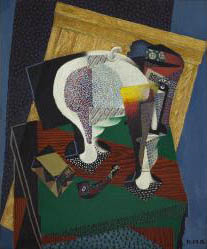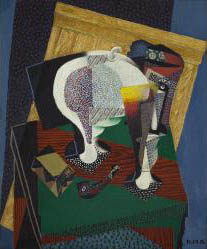
Diego Rivera
Mexican, 1886 - 1957
Le sucrier et les bougies (Sugar Bowl and Candles)
1915
Oil on canvas
25 1/8 x 21 1/8 in. (63.8 x 53.7 cm)
Framed: 30 1/8 x 25 7/8 x 1 3/4 in. (76.5 x 65.7 x 4.4 cm)
Diego Rivera was one of the most prominent Mexican artists of the twentieth century. He is perhaps best known for his large-scale murals with social themes, completed as part of the Mexican Mural Movement: government-sponsored, large public artworks that celebrated Mexican culture and glorified the Mexican Revolution. His Cubist paintings, completed during a stay in Paris, are less well-known, but are important as the artist was beginning to explore the issues of nationalism and social politics during this time—themes that would later become prominent in his work in Mexico.
Rivera experimented with a number of styles in Paris. In his Cubist paintings, he adopted the multiple perspectives and fragmented forms of European Cubists such as Picasso and Braque, but also made his own adaptations of the style, combining vibrant colors, textured surfaces, and Pointillism. He also remained deeply rooted in his Mexican heritage. In this still life, Rivera is working with many images that relate to his homeland and its relationship with Europe: the pipe refers to the ancient tradition of tobacco cultivation in Mexico and its subsequent introduction to European culture. The sugar bowl and candles may refer to the Mexican tradition of placing sugar skulls on the altar during the celebration of the Dia de los Muertos, and also to the European use of sugar as part of the ritual of pouring absinthe, an alcoholic beverage that was banned in Europe the year Rivera completed this painting. Le sucrier et les bougies is one of three Rivera paintings acquired by Alfred Stieglitz.

